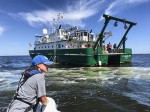A team of UCLA oceanographers towed a small boat to Louisiana to study water currents in the Gulf of Mexico last month.
UCLA, with a consortium of institutions, studied how oceanic currents move oil in areas affected by the 2010 BP oil spill, the world’s largest accidental marine oil spill. As part of its settlement after the spill, BP funded the consortium’s research through the Gulf of Mexico Research Initiative.
Jeroen Molemaker, an associate atmospheric and oceanic sciences researcher who led the multi-institutional research team, said the experiment focused on small-scale processes in the ocean that cause oil to accumulate rather than spread.
Molemaker said objects and substances thrown in the water typically spread out over a large area. In an experiment in the Gulf last year, researchers released hundreds of GPS devices called drifters that move with the current and show where the oil might go.
The drifters covered almost the entire Gulf after a few months, he said. However, they also accumulated in concentrated areas in some parts of the Gulf.
“You want to go where oil naturally accumulates and sweep it up,” Molemaker said.
Molemaker said oil, plants and debris collect on top of fronts, areas where the water’s density changes sharply because of differences in temperature or salinity. For example, the researchers performed the latest experiment south of Grand Isle, Louisiana, where freshwater from the Mississippi River flows into the salt water of the Gulf.
These density differences govern the currents but are hard to observe clearly with satellites because they can occur across just a few meters, Molemaker said. He added fronts are also difficult to study because they move and change shape.
To deal with this, Molemaker said UCLA used its Zodiac boat, which allowed the researchers to quickly travel to the location of a front. Once they arrived, the team used an array of instruments designed to measure properties of the water around a front.
“I’ve done this type of work in the past with a slower boat,” Molemaker said. “Often, whatever you’re trying to look at has deformed beyond recognition or has gone by the time you get there.”
[Related: Students plunge into ocean research through UCLA Marine Operations]
Lucia Bertero, one of the UCLA researchers, said the team set out from the harbor before sunrise each morning. Several boats would meet with a large research vessel from the University of Miami to pick up drifters.
She said an aircraft would identify fronts with infrared imaging throughout the night. Each boat would go to different fronts and quickly deploy drifters at equally spaced intervals.
“(We’d say) 100 meters, 50 meters, 10 meters, deploy!’ Bertero said. “Throw the drifter over, write down the number of the drifter and the time, and go off to the next one.”
Afterward, the team would measure water properties while slowly following the drifters and the front, Bertero said. They used an instrument called an acoustic Doppler profiler, which uses sonar to measure the velocity of the current below the boat.
The researchers also measured temperature and salinity near the water surface in real time, Bertero said. Sensors attached along a metal wire logged simultaneous measurements at many different depths.
“This instrument array is relatively innovative,” Molemaker said. “We have a measurement every 20 or 30 centimeters as opposed to 200 meters. (Otherwise) you cannot measure these fronts that have horizontal scales of a couple meters.”
Carissa Leith, one of the UCLA researchers, said she thinks it was important for the researchers to quickly address problems with the instruments on the Zodiac during their experiment.
“This small, fast boat with a lot of instruments (is) not normal,” Leith said. “It’s not like a cookie cutter, this is how we’re going to do it every day. We’re really diving into this field.”
Bertero and Leith said they became interested in oceanography research after going aboard the Zodiac during a class field trip. They joined the UCLA Marine Operations program because it allows undergraduate students to use the boat for research projects.
Molemaker said new instruments UCLA obtained for the experiment in the Gulf will provide more opportunities for UCLA students to study oceanic flows with the Zodiac in different portions of the Pacific, including Santa Monica Bay and Santa Barbara Channel.
“The first objective is to learn about transport of oil (by currents),” Molemaker said. “Secretly, we’re physicists, oceanographers. We just want to learn more about the ocean.”
